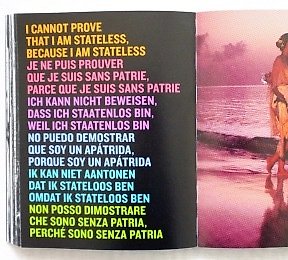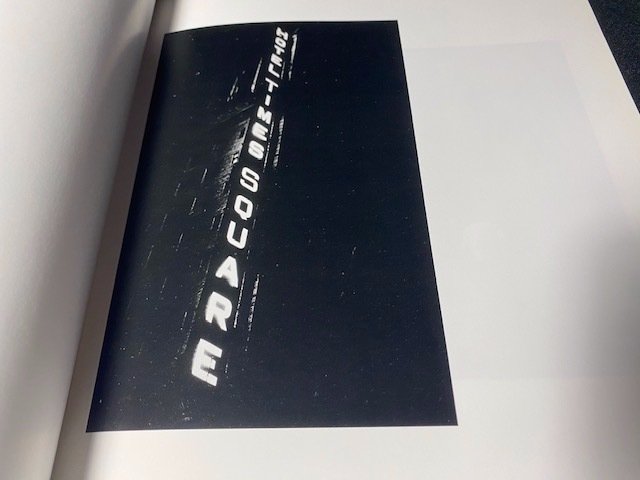
Ad van Denderen - Go No Go - 2003
N. 82427207

N. 82427207

VERY SCARCE OPPORTUNITY to purchase this EXCELLENT WEEGEE ("The Famous") TITLE -
in BRANDNEW CONDITION.
Fantastic Weegee catalogue book, published on the occasion of the exhibition "Weegee's Story - From the Berinson Collection" at "Rupertinum Salzburg", at "Museum of Modern Art Oxford" and at "Magasin 3 Stockholm Konsthall".
New, mint, unread.
IF YOU WIN MORE THAN 1 OF MY BOOKS IN THIS AUCTION, YOU WILL PAY ONLY 1 X SHIPPING COSTS - WORLDWIDE.
Rupertinum Salzburg; EBS, Verona. 1999. First edition, first printing.
Paperback (as issued). 240 x 277 mm. 128 pages. Edited by Margit Zuckriegl. Graphic design: Kanzlei, Salzburg. Translations from American english: Peter Waterhouse, from German: Gail Schamberger. Text in German and English.
"Weegee, the famous" at it's best - in perfect condition.
In this fresh and flawless condition really hard to find.
"Weegee, born Usher Fellig on June 12, 1899 in the town of Lemburg (now in Ukraine), first worked as a photographer at age fourteen, three years after his family immigrated to the United States, where his first name was changed to the more American-sounding Arthur. Self-taught, he held many other photography-related jobs before gaining regular employment at a photography studio in lower Manhattan in 1918. This job led him to others at a variety of newspapers until, in 1935, he became a freelance news photographer. He centered his practice around police headquarters and in 1938 obtained permission to install a police radio in his car. This allowed him to take the first and most sensational photographs of news events and offer them for sale to publications such as the Herald-Tribune, Daily News, Post, the Sun, and PM Weekly, among others. During the 1940s, Weegee's photographs appeared outside the mainstream press and met success there as well. New York's Photo League held an exhibition of his work in 1941, and the Museum of Modern Art began collecting his work and exhibited it in 1943. Weegee published his photographs in several books, including Naked City (1945), Weegee's People (1946), and Naked Hollywood (1953). After moving to Hollywood in 1947, he devoted most of his energy to making 16-millimeter films and photographs for his "Distortions" series, a project that resulted in experimental portraits of celebrities and political figures. He returned to New York in 1952 and lectured and wrote about photography until his death on December 26, 1968.
Weegee's photographic oeuvre is unusual in that it was successful in the popular media and respected by the fine-art community during his lifetime. His photographs' ability to navigate between these two realms comes from the strong emotional connection forged between the viewer and the characters in his photographs, as well as from Weegee's skill at choosing the most telling and significant moments of the events he photographed. ICP's retrospective exhibition of his work in 1998 attested to Weegee's continued popularity; his work is frequently recollected or represented in contemporary television, film, and other forms of popular entertainment."
- Lisa Hostetler -
"Weegee worked in Manhattan's Lower East Side as a press photographer during the 1930s and 1940s and developed his signature style by following the city's emergency services and documenting their activity.[2] Much of his work depicted unflinchingly realistic scenes of urban life, crime, injury and death. Weegee published photographic books and also worked in cinema, initially making his own short films and later collaborating with film directors such as Jack Donohue and Stanley Kubrick.
Weegee was born Ascher (later modified to Usher) Fellig in Złoczów (now Zolochiv, Ukraine), near Lemberg in Austrian Galicia. His given name was changed to Arthur after he immigrated with his family to New York in 1909. The father of the family, Bernard Fellig, emigrated in 1908, followed in 1909 by his wife and their four children, including "Usher Felik", as his name was spelled on the steerage passenger list of the steamship, Kaiserin Auguste Victoria. In Brooklyn, where they settled, he took numerous odd jobs, including working as a street photographer of children on his pony[3] and as an assistant to a commercial photographer. In 1924 he was hired as a darkroom technician by Acme Newspictures (later United Press International Photos). He left Acme in 1935 to become a freelance photographer. Describing his beginnings, Weegee stated:
In my particular case I didn't wait 'til somebody gave me a job or something, I went and created a job for myself—freelance photographer. And what I did, anybody else can do. What I did simply was this: I went down to Manhattan Police Headquarters and for two years I worked without a police card or any kind of credentials. When a story came over a police teletype, I would go to it. The idea was I sold the pictures to the newspapers. And naturally, I picked a story that meant something.
He worked at night and competed with the police to be first at the scene of a crime, selling his photographs to tabloids and photographic agencies. His photographs, centered around Manhattan police headquarters, were soon published by the Daily News and other tabloids, as well as more upscale publication such as Life magazine.
In 1957, after developing diabetes, he moved in with Wilma Wilcox, a Quaker social worker whom he had known since the 1940s, and who cared for him and then cared for his work. He traveled extensively in Europe until 1964, working for the London Daily Mirror and on a variety of photography, film, lecture, and book projects. On December 26, 1968, Weegee died in New York at the age of 69.
The origin of Fellig's pseudonym is uncertain. One of his earliest jobs was in the photo lab of The New York Times, where (in a reference to the tool used to wipe down prints) he was nicknamed "squeegee boy". Later, during his employment with Acme Newspictures, his skill and ingenuity in developing prints on the run (e.g., in a subway car) earned him the name "Mr. Squeegee". He may subsequently have been dubbed "Weegee"—a phonetic rendering of Ouija—because his instant and seemingly prescient arrivals at scenes of crimes or other emergencies seemed as magical as a Ouija board."
(Wikipedia)
Come fare acquisti su Catawiki
1. Scopri oggetti speciali
2. Fai l’offerta più alta
3. Paga in tutta sicurezza